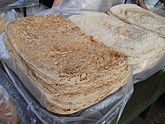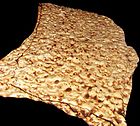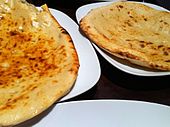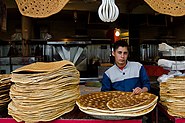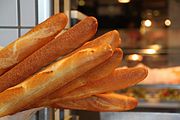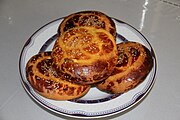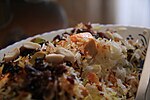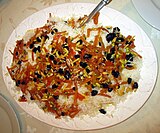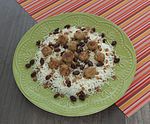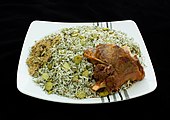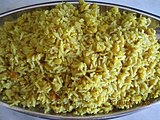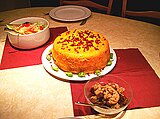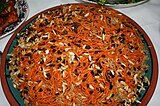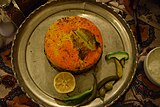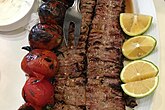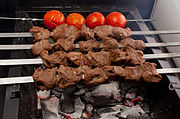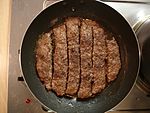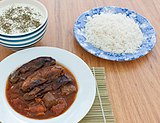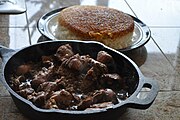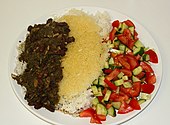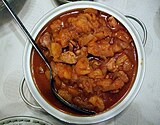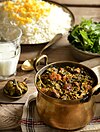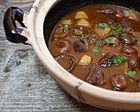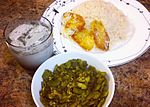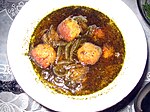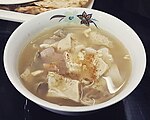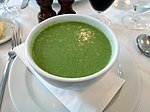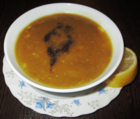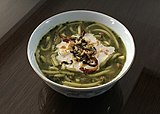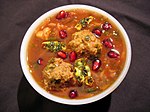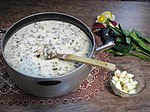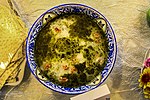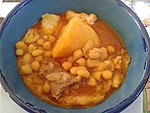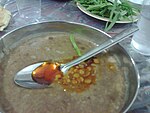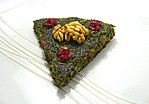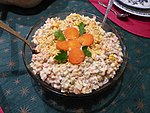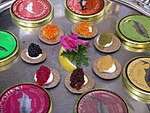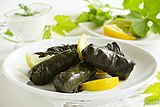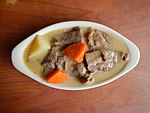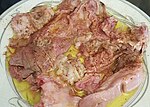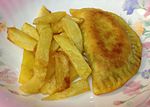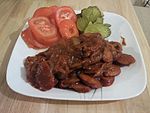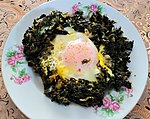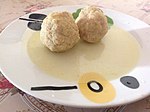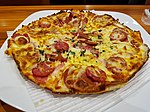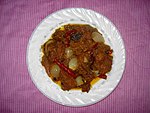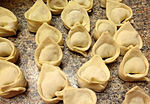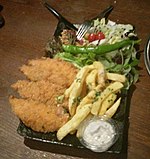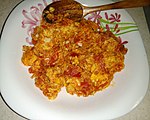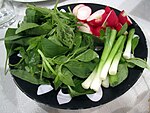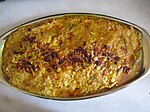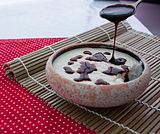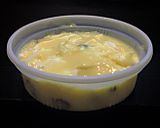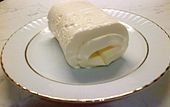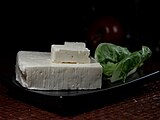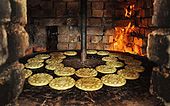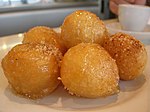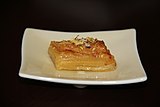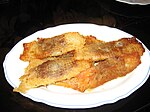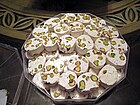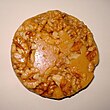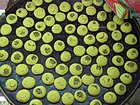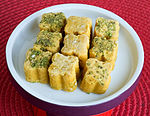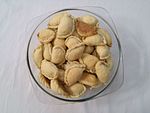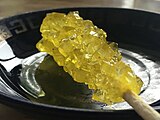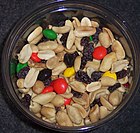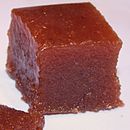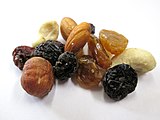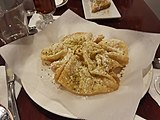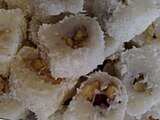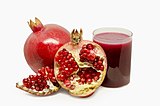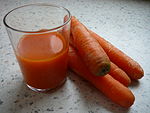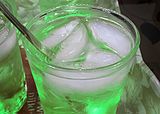
Kebab, kabob, kebap, or kabab is roasted meat that originates from the Middle East. Many variants of the category are popular around the world, including the skewered shish kebab and the doner kebab with bread.

Ghormeh sabzi or Khoresht sabzi, also spelled qormeh sabzi, is an Iranian herb stew. It is considered the national dish and is a very popular dish in Iran. Ghormeh sabzi has different variants, which are based on the difference between beans and meat.

Iranian cuisine is the culinary traditions of Iran. Due to the historically common usage of the term "Persia" to refer to Iran in the Western world, it is alternatively known as Persian cuisine, despite Persians being only one of a multitude of Iranian ethnic groups who have contributed to Iran's culinary traditions.

Chelow kabab is an Iranian dish consisting of steamed rice and one of the many varieties of Iranian kebab. It is considered the national dish of Iran, and was probably created by the time of the Qajar dynasty.

Najmieh Khalili Batmanglij is an Iranian-American chef and cookbook author. Born in Tehran, she fled the Iranian Revolution in 1979, moving first to France, then the United States, building a career as a cookbook author as she went. Her first book, published in French, was called Ma Cuisine d’Iran (1984), followed by eight cookbooks in English, from Food of Life (1986) to Cooking in Iran (2018). The Washington Post hailed her in 2018 as "the grande dame of Iranian Cooking."
Kateh is an Iranian rice dish from the Caspian region of Iran. Unlike Polo/Cholo, kateh is sticky and does not have tahdig, though it does form a crust on the bottom where the salt and oil collect. Generally, kateh needs half the cooking time of polo-style rice and has a denser flavor due to the addition of butter or oil in the cooking process.

Khoresh or Khoresht is a generic Iranian term for stew dishes in the Iranian cuisine, Afghan cuisine, Tajik cuisine and also Kurdish cuisine. The word is a substantive of the verb khordan "to eat" and literally means "meal".

Caspian cuisine is a regional cuisine found in Northern Iran, primarily found in the Mazandaran, Gilan, Alborz, and Golestan provinces. The recipes are diverse, just like the region's landscape. Nature in the Mazandaran region of Iran is distinct and varied sections with a mixture of coastal, plains, prairies, forests, and rainforests. The Mazandarani cuisine of coastal regions is very different from that of mountainous regions since people settled in the Alborz usually use the indigenous herbs, while coastal populations prepare dishes using local fish and Caspian (Mazani) rice with vegetables.
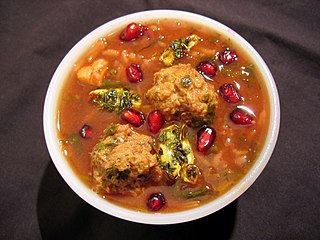
Pomegranate soup is an Iranian dish made from pomegranate juice and seeds, yellow split peas, mint leaves, spices, and other ingredients. It is regarded as an āsh, which is the Iranian term for a "thick soup". This soup has different types and forms in Iran.
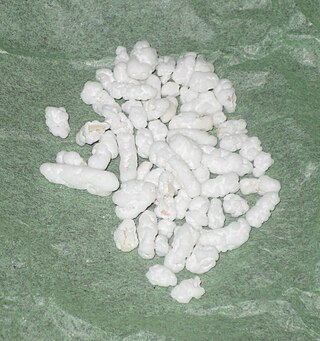
Mlabbas, and Noghl, or Nuql, or sugar-coated almonds, is a traditional Syrian, Iranian and Afghan confection. It is made by boiling sugar with water and rose water and then coating roasted almonds in the mixture. It can also be made with other nuts such as walnuts or other items. Noghl is often eaten along with tea.
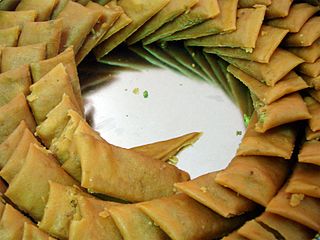
Sohan is a traditional Persian saffron brittle toffee made in Iran. Its ingredients consist of wheat sprout, flour, egg yolks, rose water, sugar, butter or vegetable oil, saffron, cardamom, and slivers of almond and pistachio.

Strawberry delight is a dessert salad found in the United States, especially in the South and more rural areas of Minnesota. Strawberry delight is made from milk, whipped topping, cream cheese, strawberries and strawberry gelatin over a graham cracker crust. Variations include ingredients such as ice cream, canned fruit, marshmallows, lemon juice, and walnuts. The crust ingredients are mixed and pressed in a pan with the creamy ingredients mixed and added on top. Boiling water is added to the strawberry gelatin mix, strawberries are added to it, and then that mixture is poured over the creamy mixture in the pan, all of which is then refrigerated to set.

Kuku or kookoo is an egg-based and often vegetarian Iranian dish made of whipped eggs folded in various ingredients. It is similar to the Italian frittata, the French quiche, or an open-faced omelette, but it typically has less egg than a frittata, and it cooks for a shorter amount of time, over a low heat, before turned over or grilled briefly to set the top layer. It is served either hot or cold as a starter, side dish or a main course, and is accompanied with bread and either yogurt or salad.

Shirazi salad is an Iranian salad that originated from and is named after Shiraz in southern Iran. It is a relatively modern dish, dating to sometime after the introduction of the tomato to Iran at the end of the nineteenth century in the Qajar era. Its primary ingredients are cucumber, tomato, onion, olive oil, herbal spices and verjuice, although lime juice is sometimes used in its preparation. In Iran, it is eaten in the summer as a side dish on its own, and year-round as a side dish alongside meat-based foods such as kebab and as a side dish before and after meals. Shirazi salad is sometimes served as an accompaniment to rice such as loobia polo, an Iranian rice dish made with green beans and tomatoes. Cookbook author Jila Dana-Haeri describes it as a refreshing dish during the summer.
Loobia polo is an Iranian dish of rice, green beans, and beef or lamb. In the Persian language, loobia means bean while polo is a style of cooked rice, known in English as pilaf. It is made by sautéing onion with a touch of turmeric powder followed by mixing the beef, then adding the cooked green beans with salt and pepper. You can always add cinnamon for an extra sense of flavor. This is then layered with half-cooked rice in another pot and steamed until done.

Baghalaa polow ; is an Iranian dish of rice, fava beans and dill. In Persian, baghalaa means fava bean while polo is pilaf, a style of cooked rice. It is made by cooking rice and green broad beans in boiling water. When cooked, the rice and beans are layered with dill in a pan, and everything is baked in an oven until ready. Saffron water can also be added to the rice. It is typically served with meat. Like other Iranian traditional foods, the dish may be served at special occasions and family gatherings.

Shirin polo, also commonly known as Persian wedding rice or Rosh Hashanah rice, is a traditional Persian rice pilaf that is commonly served to mark special occasions such as weddings. It is a simplified version of morassa' polō, lit. 'jeweled rice'.

Khoresh karafs is a traditional Iranian dish. As the name suggests, celery is the main part of this dish.

Maideh Mazda (1922-2012) was a Persian food expert, linguist, and author, born and raised in Baku, Azerbaijan in an Iranian family. She published one of the first cookbooks about Persian cuisine for American readers. Entitled In a Persian Kitchen, her cookbook first appeared in 1960 and went through nineteen hardcover editions by the time of her death in 2012. With her husband Charles T. Magee, a member of the U.S. Foreign Service, Mazda traveled to Bulgaria, Canada, France, Latvia, the Soviet Union, Switzerland and Ukraine, where she hosted a number of diplomatic functions. A purveyor of culinary diplomacy in the decades before the Iranian Revolution of 1978-79, she promoted understanding of Iranian and Persian culture among Americans through her cookbooks, public lectures, and demonstrations.

